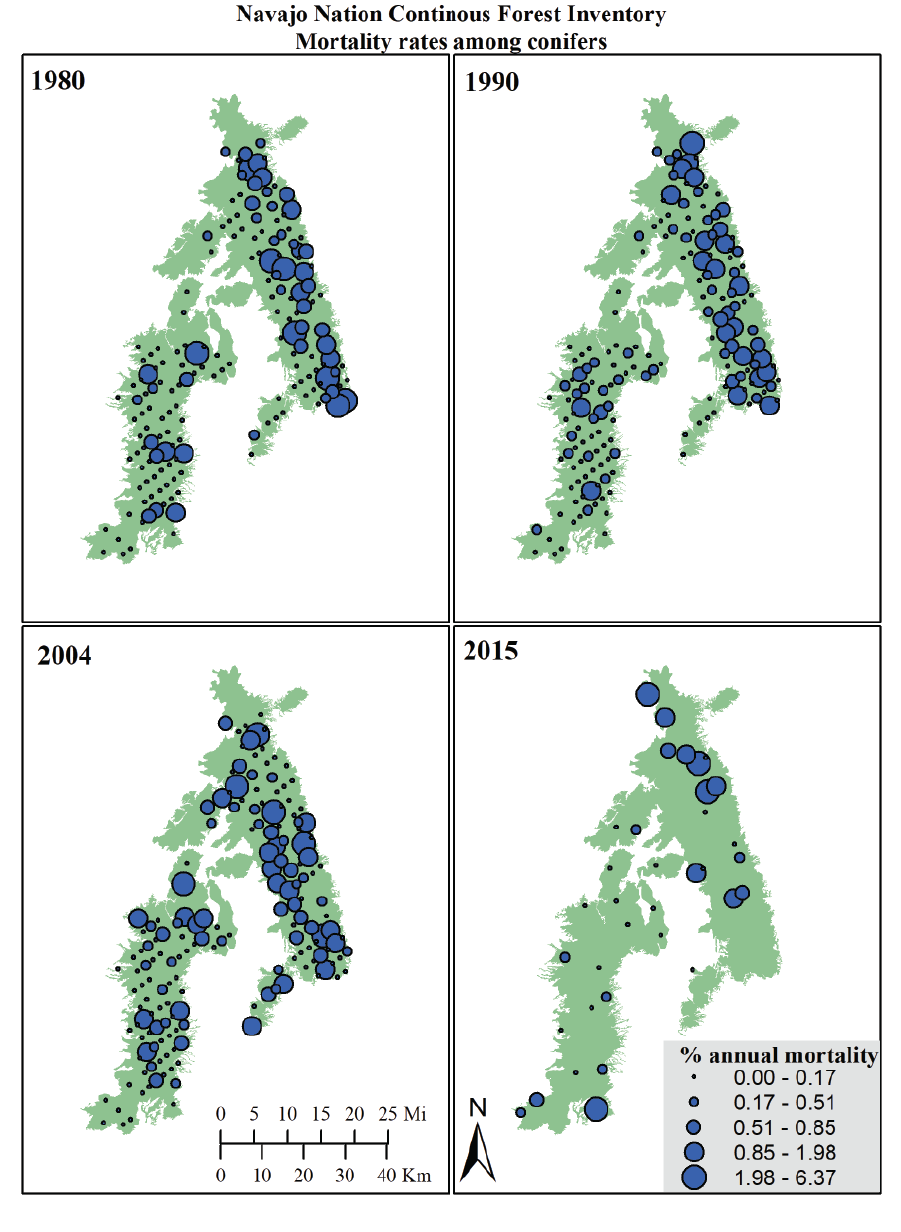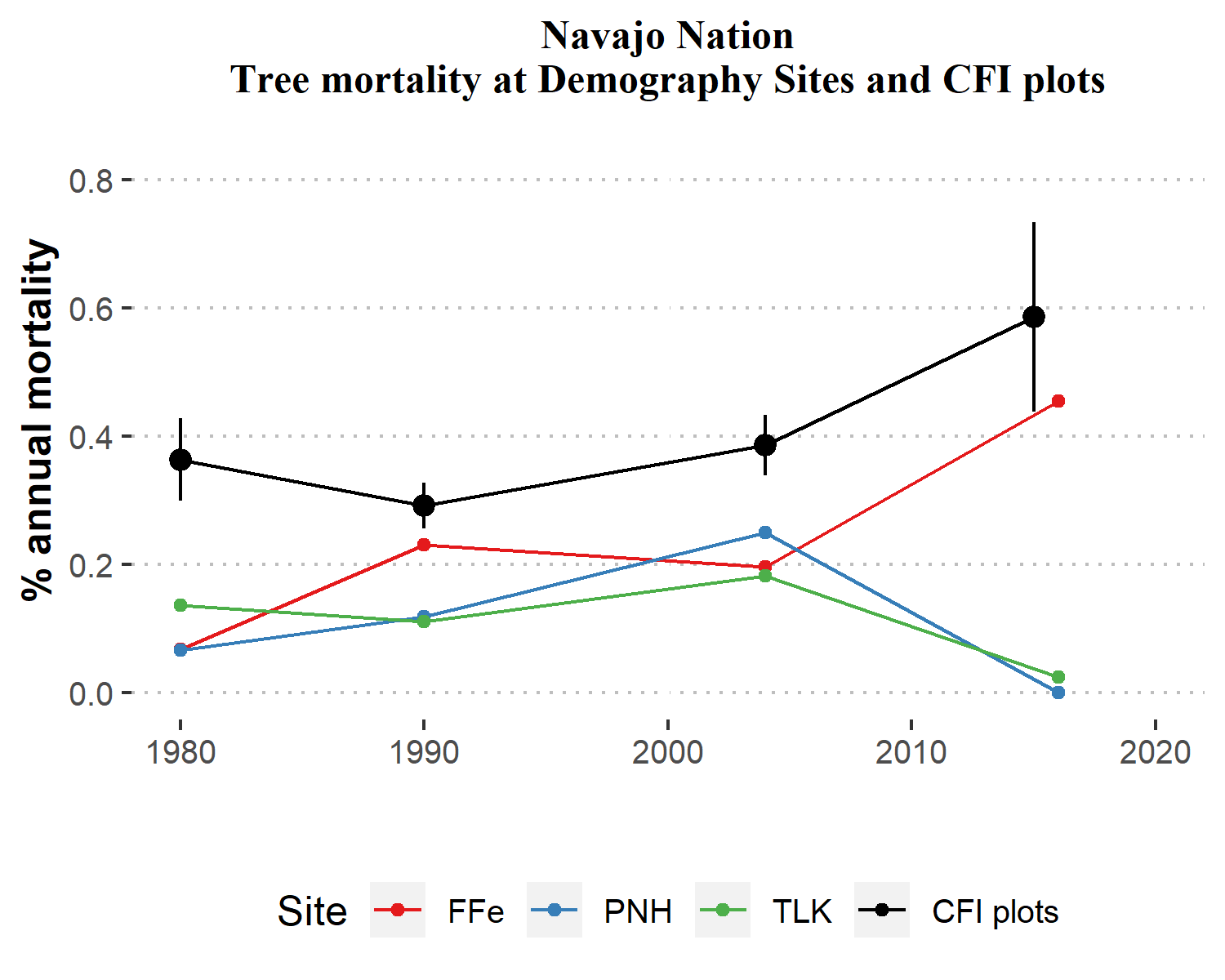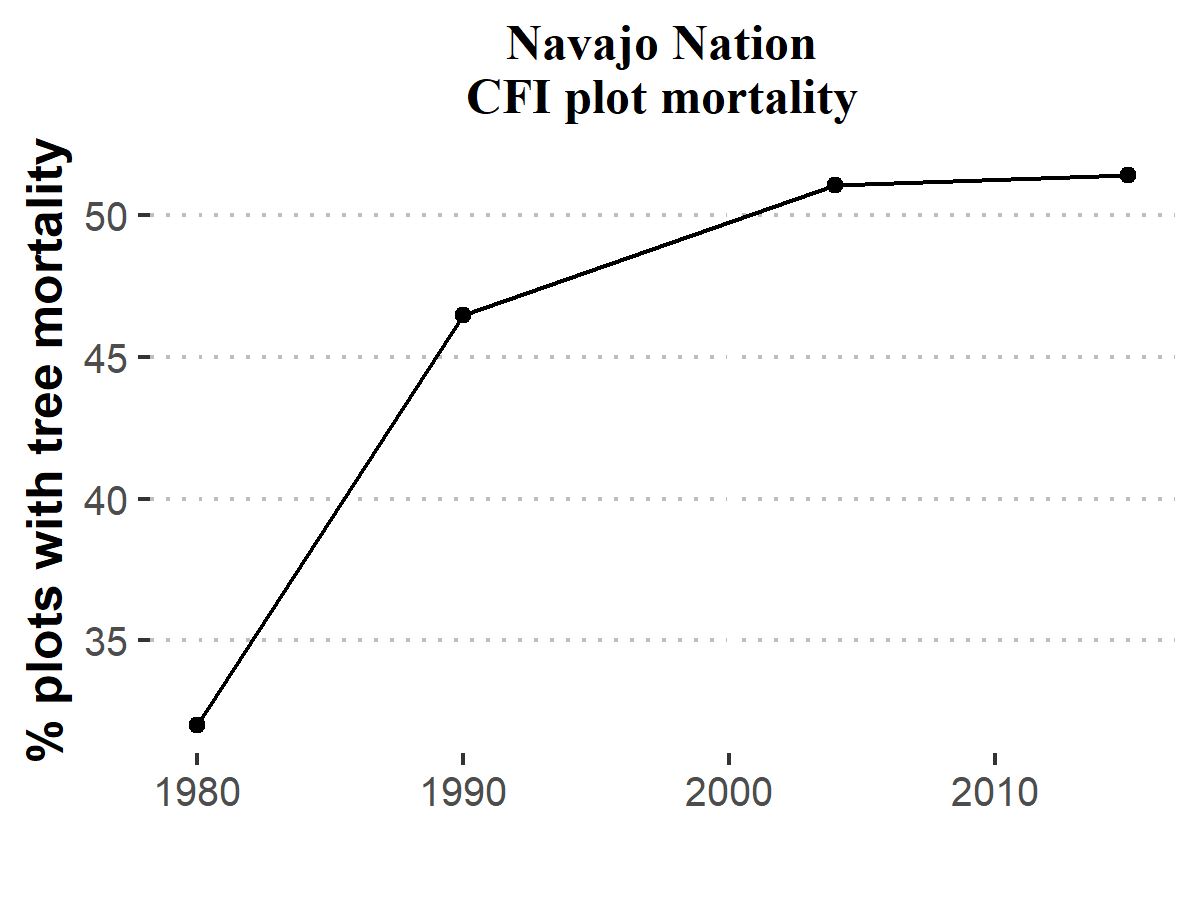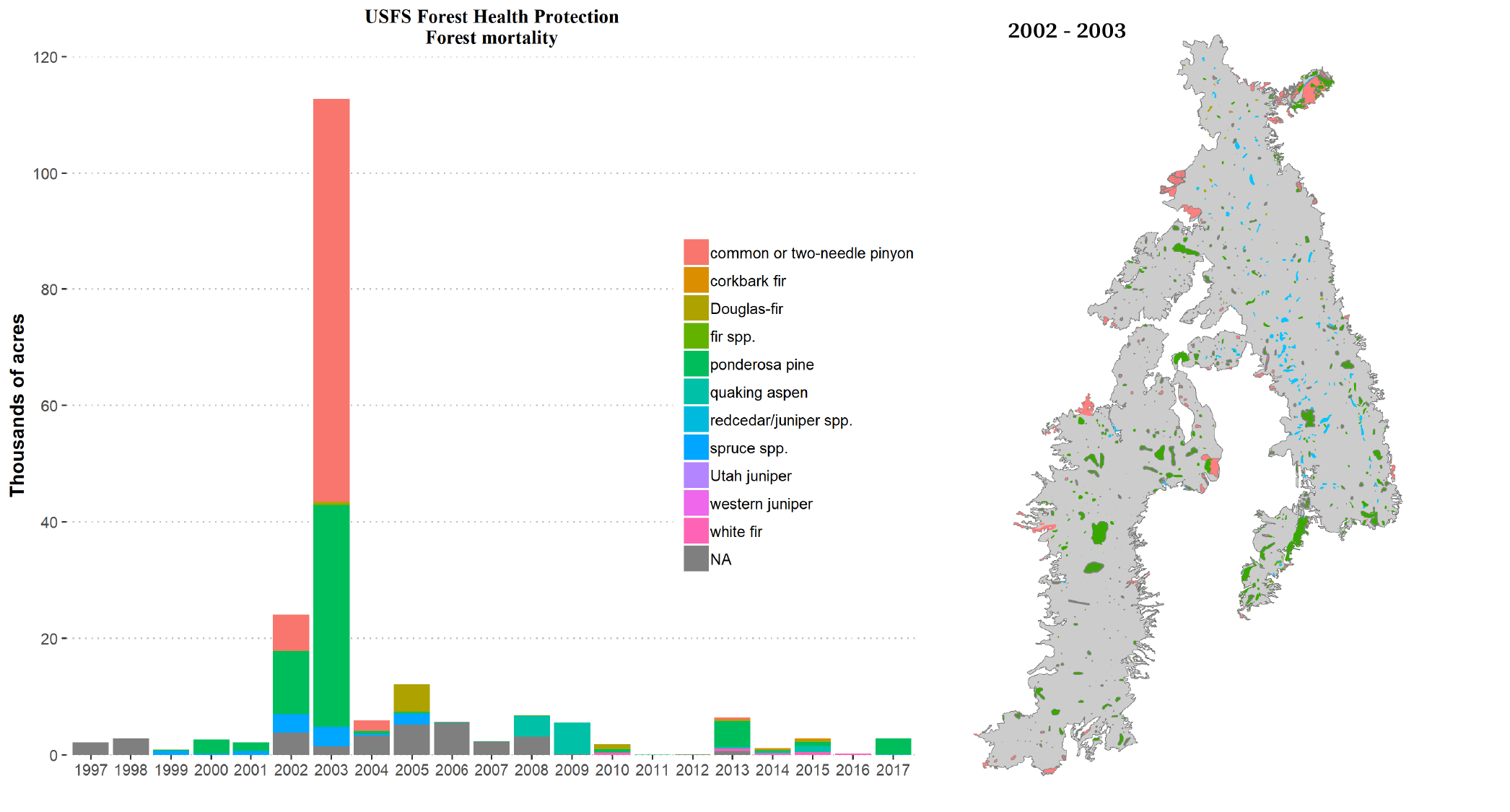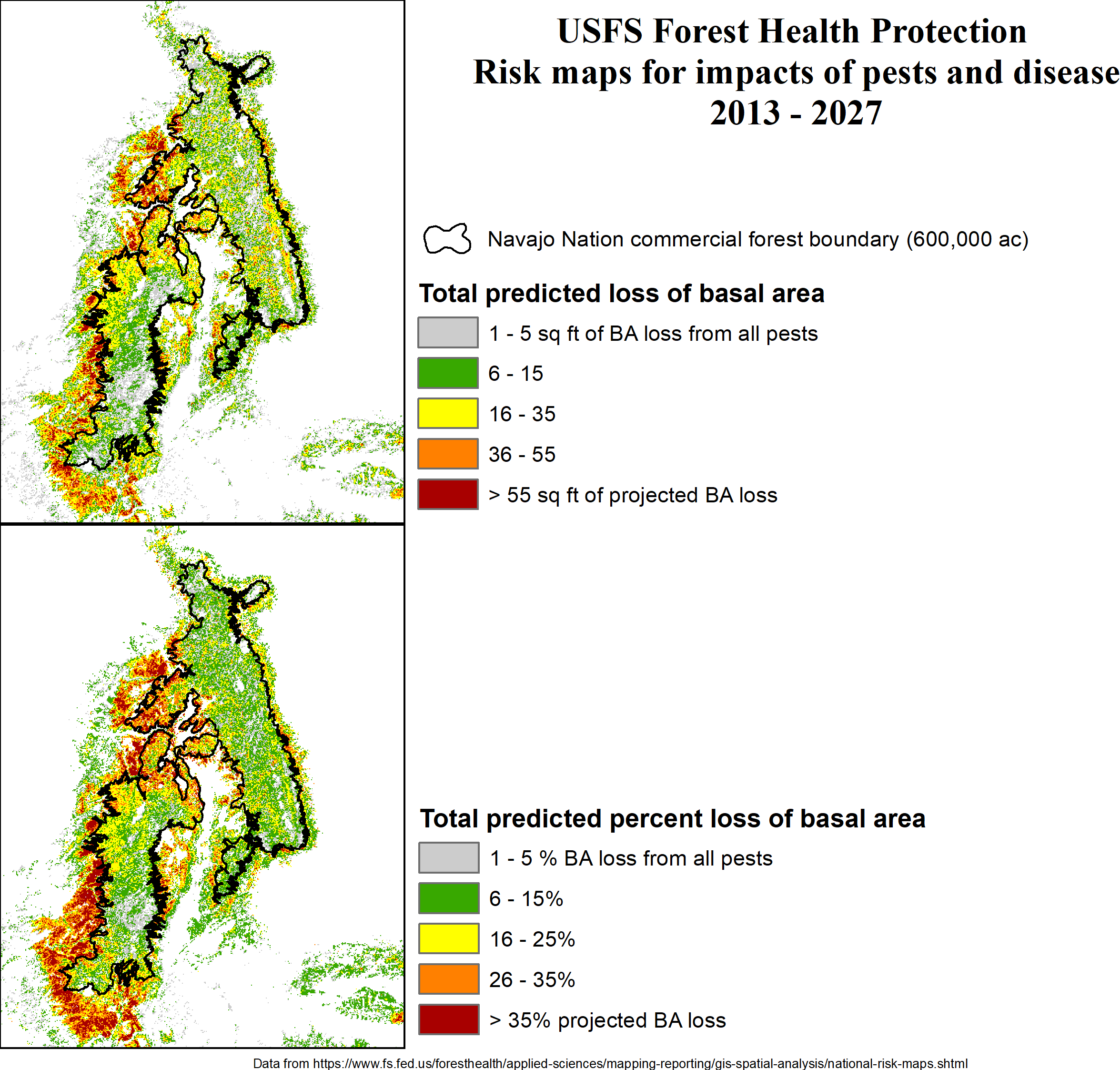Section 6 Tree mortality
With a warming climate, the Southwest will experience more years of drought. Droughts, in turn, will grow more severe as a warming atmosphere draws more and more water from soil and plants9. As trees experience greater water and heat stress, their resistance to insects and disease decline, and especially for older trees, that means a greater likelihood of dying. Drought and heat related factors have already begun to take effect, raising rates of forest mortality across the western US22 and, indeed, globally with climate change21. Future warming is likely to amplify these patterns, making heat-stress and drought-associated disturbances (like wildfire) more common and more severe15,82. The patterns, causes, and consequences of tree mortality and large-scale die-off events have received substantial attention among researchers in recent years. As summarized by 20, who examined >400 studies world-wide, some key lessons have emerged:
warming increases the severity of drought
mortality occurs more quickly during drought
drought events in the Southwest can last for multiple years or even decades
short-duration droughts are much more common, but can become lethal to trees under warmer conditions
mortality rates can exceed the pace of forest recovery, causing declines in forest health and productivity.
While traveling through Navajo forests conducting fieldwork over the last half-decade, we have noted various instances of tree mortality (Figure 6.1). At times, clumps of dead or dying trees were enough to cause concern over more general patterns regarding forest health. But these observations are not enough to develop sound judgement about a dynamic process like tree mortality. In this section, we present trends and rates of tree mortality from Navajo forest inventory plots and from our three demography study sites. We selected our demography sites to represent some of the oldest stands in the Navajo forest because recent studies suggest that large old trees may be the most vulnerable to reduced growth and increased mortality in a changing climate83,84. Large old trees are also the most rare and hardest to replace trees in the forest, and their benefits may not be fulfilled by smaller trees85. In other words, old-growth forests are a rare and unique resource that deserve preservation and care, and they may also serve as a canary in the coal mine for the broader Navajo forest area, foretelling us of widespread changes to come.
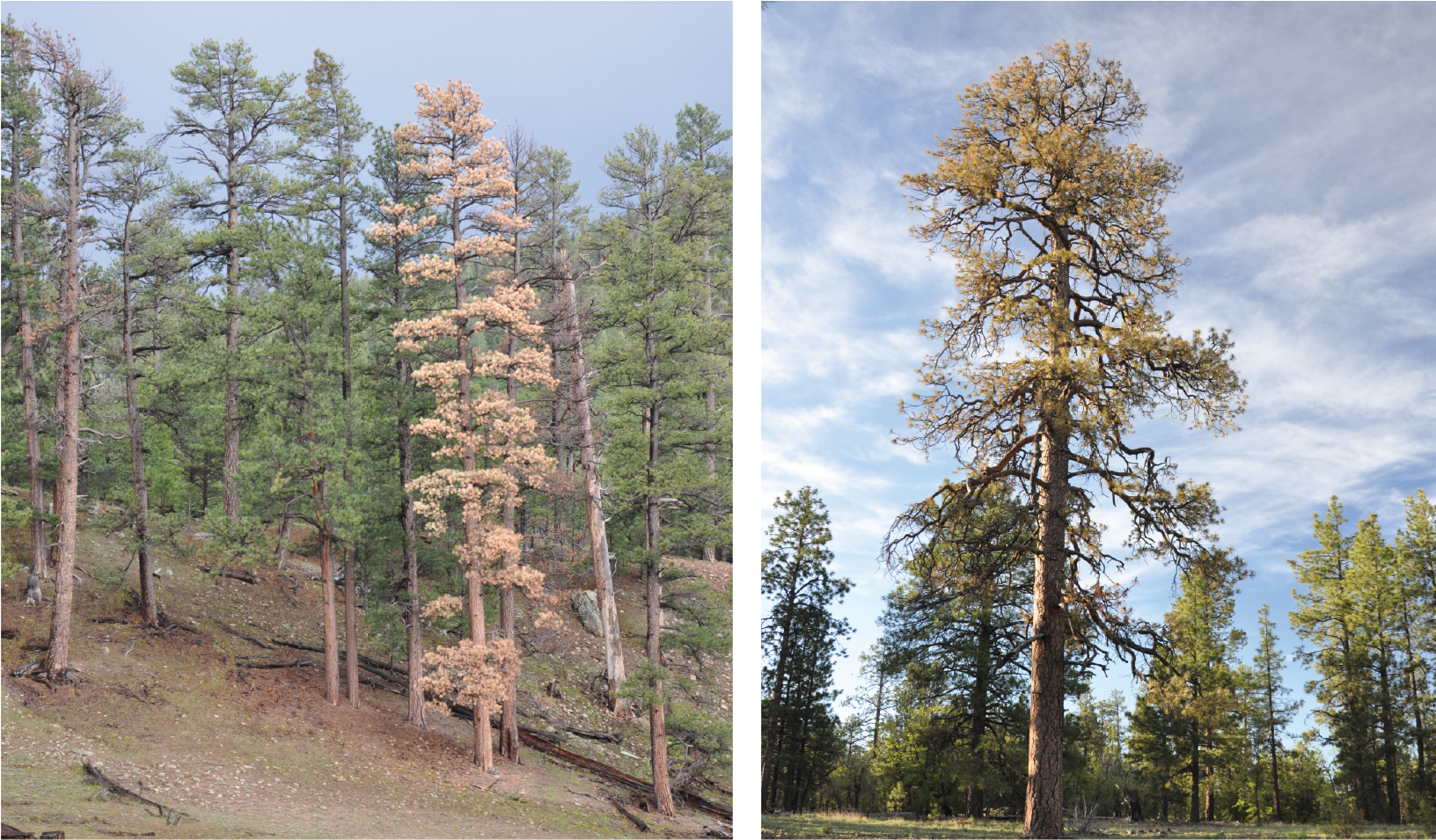
Figure 6.1: Examples of recent tree mortality. At left, old Ponderosa pines in the Lukachukai area of the Chuska Mountains. Four of the trees shown here died 2006-2016. The red-colored tree at center died in 2015. At right, a 400-year old ponderosa pine on the Defiance Plateau. We dated the tree’s germination to 1613, and it died in 2015. The following year it was cut by local tribal members for fuelwood. Photo credit: C. Guiterman.
6.4 Conclusions
Climate change is making conditions for conifer trees in the Southwest more stressful. Warmer temperatures turn average years into drought years and aggravate drought conditions. This raises the potential for widespread tree mortality from a variety of causes, including heat stress, water limitations, insects, disease, and fire. Monitoring the rates and areas of tree mortality is a key component to understanding and managing for forest health. Here, we have synthesized over three decades of forest plot measurements and added new tree-ring reconstructions of tree mortality at three representative old forest sites. Overall rates of conifer tree mortality were quite low (0.2-0.3% per year) and not out of bounds for general expectations of background mortality levels in semi-arid pine-dominated forest ecosystems.
Rather than portend broadscale changes for the Navajo forest resource, the old-growth demography sites probably better represent some of the most robust drought-tolerant sites in the forest. Many of the trees are over 300 years old, having survived multiple prolonged droughts in their lifetimes. These low- to mid-elevation sites, such as Tohatchi Lookout (TLK) and PNH, as well as CFI plots on the Defiance Plateau are among the longest-lived forest stands of the Navajo forest. Upper-elevation sites, similar to FFe, have greater productivity and thus greater turn-over, where maximum lifespans are shorter and new trees often readily replace older, dying trees. Thus we should expect somewhat higher rates of background tree mortality at upper-elevations. But conversely, the lower-elevation edge of tree distributions most often succumb to drought-induced tree die-off88,89, and that is what we have not yet seen in Navajo forests. Large areas of the Chuska Crest were also some of the most heavily logged sites in Navajo forests, creating younger stands with high levels of competition. Competition often leads to mortality of less-competitive individuals, and the winners grow stronger, larger, and more dominant. These stand dynamics are at work across most of the Chuska Mountains area, and could account for much of the annual mortality found there. Another effect of past logging was to remove the largest and oldest individuals; trees that otherwise may be succumbing to mortality now had they remained in the forest. Those past removals may have offset mortality rates and lowered the overall average for decades.
Increased mortality since 2004 at the upper-elevations, however, may be the signal that conditions are changing. Ongoing drought and warmer temperatures may be starting to stress trees beyond their capacity for resistance to drought in areas that have not really experienced much drought over at least the last century or longer (see Tree growth response to climate). Although mortality rates at the upper-elevation sites are beginning to rise to levels seen a decade ago across western US forests22, we recommend further monitoring of drought conditions and tree mortality to aid in understanding how climate change is impacting and will further impact this significant forest resource.
Given some grim projections of forest drought stress15 and the potential for even greater tree mortality in the region82 with climate change, it is reassuring to find that such dramatic changes have not yet affected much of the Navajo forest. Although, threats loom and increased mortality is likely. Temperatures are on the rise, exacerbating drought conditions and potentially affecting tree resilience to insect attack and fire. Regional patterns of tree mortality, insects, and fire behavior should still give us pause, and put us on alert for such changes in Navajo forests.
References
9. Breshears, D. D. et al. The critical amplifying role of increasing atmospheric moisture demand on tree mortality and associated regional die-off. Frontiers in plant science 4, 266 (2013).
22. van Mantgem, P. J. et al. Widespread increase of tree mortality rates in the western United States. Science (New York, N.Y.) 323, 521–524 (2009).
21. Allen, C. D. et al. A global overview of drought and heat-induced tree mortality reveals emerging climate change risks for forests. Forest Ecology and Management 259, 660–684 (2010).
15. Williams, A. P. et al. Temperature as a potent driver of regional forest drought stress and tree mortality. Nature Climate Change 3, 292–297 (2013).
82. McDowell, N. G. et al. Multi-scale predictions of massive conifer mortality due to chronic temperature rise. Nature Climate Change 6, 295–300 (2016).
20. Allen, C. D., Breshears, D. D. & McDowell, N. G. On underestimation of global vulnerability to tree mortality and forest die-off from hotter drought in the Anthropocene. Ecosphere 6, art129 (2015).
83. Bennett, A. C., McDowell, N. G., Allen, C. D. & Anderson-Teixeira, K. J. Larger trees suffer most during drought in forests worldwide. Nature Plants 1, 15139 (2015).
84. McDowell, N. G. & Allen, C. D. Darcy’s law predicts widespread forest mortality under climate warming. Nature Climate Change 2–5 (2015). doi:10.1038/nclimate2641
85. Lindenmayer, D. B., Laurance, W. F. & Franklin, J. F. Global decline in large old trees. Science 338, 1305–1306 (2012).
44. Guiterman, C. H. Climate and human drivers of forest vulnerability in the US Southwest: Perspectives from dendroecology. 185 (University of Arizona, 2016).
86. Lewis, S. L. et al. Tropical forest tree mortality, recruitment and turnover rates: calculation, interpretation and comparison when census intervals vary. Journal of Ecology 92, 929–944 (2004).
87. Breshears, D. D. et al. Tree die-off in response to global change-type drought: mortality insights from a decade of plant water potential measurements. Frontiers in Ecology and the Environment 7, 185–189 (2009).
88. Allen, C. D. & Breshears, D. D. Drought-induced shift of a forest-woodland ecotone: rapid landscape response to climate variation. Proceedings of the National Academy of Sciences 95, 14839–42 (1998).
89. Kelly, A. E. & Goulden, M. L. Rapid shifts in plant distribution with recent climate change. Proceedings of the National Academy of Sciences of the United States of America 105, 11823–6 (2008).
